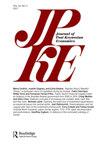比较经济分析与道德故事:对节俭神话的应用
IF 0.6
3区 经济学
Q4 ECONOMICS
引用次数: 0
摘要
2020年,欧盟制定了一项刺激计划,旨在支持成员国在2019冠状病毒病(Covid-19)大流行爆发后的经济复苏。若干国家不愿核准该方案,拒绝将财政扩张作为缓解卫生危机影响的手段。他们称自己为“节俭者”,从那时起,这个词就被媒体广泛使用。尽管没有一个经济学派以节俭或浪费来定义宏观经济特征,但节俭与挥霍经济的说法一直是欧盟层面政策谈判的主要动机。在本文中,我们通过评估与公共和私人债务、财政收入和支出、福利国家特征、劳动力市场以及内部和外部需求对经济增长的贡献相关的可观察的经济指标,分析了欧洲国家的经济行为在多大程度上可以沿着这些路线特征。我们借鉴了三种主要的理论方法,以便选择有意义的指标来比较不同的经济结构。关键词:比较经济学欧盟节俭地中海国家福利国家披露声明作者未报告潜在的利益冲突。注1关于NGEU特性的更多细节见Freier et al. (Citation2022)有关这些范式演变的详细分析,请参见Cárdenas、Herrero和Rial (Citation2020)成员国的业务预算余额是根据成员国分配欧盟支出的数据和成员国对欧盟预算的缴款来计算的。每个成员国的业务预算余额按分配给每个成员国的业务支出(不包括行政支出)与每个成员国调整后的“国家缴款”之间的差额计算,计算公式如下:OBBi=: TAEi -: H5i -: TNCi·TAEEU - H5EUTNCEU。式中:OBBi =会员国的业务预算余额,TAEi =会员国的分配支出总额,H5i =分配给会员国的行政支出,TNCi =会员国的国家捐款总额。4意大利是唯一一个在本分析期间保持正捐款的南方国家欧元危机也被称为“欧洲债务危机”,指的是2009年至2010年这段时间,在金融脆弱性、银行救助和寻求利用欧盟制度障碍的投机立场的背景下,南方国家的公共债务利率急剧上升。6这一特征适用于西班牙、葡萄牙和希腊,但不包括意大利。7在过去的几十年里,福利国家的改革并不仅仅关注支出。有声音迫切要求通过实施更接近美国的模式来改变其面貌,用经济状况调查的福利取代普遍权利,将福利生产从公共部门转移到私营部门,并通过对劳动力征税而不是对资本征税来为福利国家提供资金(Palley Citation2020)使用传统的阈值等于中位数的60%,导致有关贫困演变的记录多年来受到质疑。例如,Missos (Citation2021)指出,如果2009年的实际门槛保持不变,2014年希腊51.6%的人口将降至贫困线以下。本研究得到了项目资助Generación de Conocimiento 2022。本文章由计算机程序翻译,如有差异,请以英文原文为准。
Comparative economic analysis vs moralistic tales: an application to the myth of frugality
AbstractIn 2020 the European Union designed a stimulus programme aimed at supporting Member States’ economic recovery following the outbreak of the Covid-19 pandemic. Several countries were reluctant to endorse the programme rejecting the idea of fiscal expansion as a means of cushioning the impact of the health crisis. They dubbed themselves ‘the frugals’, a term extensively used in media coverage from then on. The narrative of thrifty versus profligate economies has been a leitmotiv in policy negotiations at the EU level despite the fact that no economic school of thought defines macroeconomic characteristics in terms of frugality or wastefulness. In this paper we analyze to what extent the economic behavior of European countries can be characterized along those lines by assessing observable economic indicators related to public and private indebtedness, fiscal income and spending, characteristics of the welfare state, the labor market and contributions to economic growth from internal and external demand. We draw from three main theoretical approaches in order to choose meaningful indicators for comparing different economic structures.Keywords: Comparative economicsEuropean Unionfrugalsmediterranean countrieswelfare state Disclosure statementNo potential conflict of interest was reported by the author(s).Notes1 For more details on the characteristics of NGEU see Freier et al. (Citation2022).2 For a detailed analysis of the evolution of these paradigms, see Cárdenas, Herrero, and Rial (Citation2020).3 Member States' operating budgetary balances are calculated using data on the allocation of EU expenditure by Member State and on Member States' contributions to the EU Budget. The operating budgetary balance of each Member State is calculated as the difference between the operating expenditure (excluding administration) allocated to each Member State and the adjusted 'national contribution' of each Member State as follows: OBBi=: TAEi−: H5i−: TNCi·TAEEU−H5EUTNCEU. Where: OBBi = operating budgetary balance of Member State, TAEi = total allocated expenditure of Member State, H5i = administrative expenditure allocated to Member State, TNCi = total national contribution of Member State.4 Italy is the only Southern country to maintain a positive contribution in the period under analysis.5 The euro crisis also dubbed the “European debt crisis” refers to the period comprised between 2009 and 2010, when interest rates for public debt rose sharply for Southern countries in a context of financial fragility, bank bailouts and speculative positions looking to take advantage of the institutional hurdles in the EU.6 This feature applies to Spain, Portugal and Greece, but not Italy.7 During the last decades, the reforms of the welfare state have not focused solely on spending. There are voices pressing to modify its physiognomy by implementing a model closer to that of the US, replaceing universal rights with mean-tested benefits, shifting welfare production from the public to the private sector and financing the wellfare state through taxes on labor instead of taxes on capital (Palley Citation2020).8 The use of the conventional threshold equal to 60% of the median caused the records on the evolution of poverty to be questioned for several years. As an example, Missos (Citation2021) points out that if the real thresholds of 2009 had remained fixed, in 2014 51.6% of Greece’s population would have fallen below the poverty line.Additional informationFundingThis work was supported by Proyectos de Generación de Conocimiento 2022.
求助全文
通过发布文献求助,成功后即可免费获取论文全文。
去求助
来源期刊

Journal of Post Keynesian Economics
ECONOMICS-
CiteScore
1.70
自引率
10.00%
发文量
23
期刊介绍:
The Journal of Post Keynesian Economics is a scholarly journal of innovative theoretical and empirical work that sheds fresh light on contemporary economic problems. It is committed to the principle that cumulative development of economic theory is only possible when the theory is continuously subjected to scrutiny in terms of its ability both to explain the real world and to provide a reliable guide to public policy.
 求助内容:
求助内容: 应助结果提醒方式:
应助结果提醒方式:


